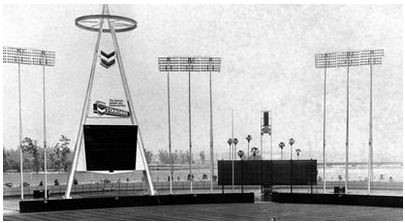When the Los Angeles Angels were born in 1961, home was a more transient notion than a place for them to call their own.
They spent their inaugural season at tiny Wrigley Field, a former minor league ballpark ill suited for Major League play with its 345-foot power alleys and paltry 20,457 seating capacity. The next year, the Angels moved into newly constructed Dodger Stadium, or Chavez Ravine as the American Leaguers called it, where they appeared as sub lessees who got to use the field while the “real” tenants were away.
The Angels needed their own home.
In the ensuing years, Angels owner Gene Autry was courted by many southland cities, including a strong wooing from Long Beach, but eventually settled on Anaheim, which offered a 160-acre parcel near the intersection of three freeways. Ground was broken Aug. 31, 1964, on the $24 million facility, and 19 months later it was ready for the Angels to move in.
The new stadium featured 43,204 seats and outfield dimensions derived from a scientific study intended to insure offensive balance. But the real calling card was the $1 million “Big A” scoreboard in left field. At 230 feet, it was the tallest structure in Orange County at the time and featured a state-of-the-art video display that could not only show fans the score and lineups, but also lead cheers and highlight statistical milestones.
The Angels hosted the San Francisco Giants for a pre-season exhibition at their new stadium on April 9, 1966, during which Willie Mays hit the “unofficial” first home run in Anaheim Stadium history.
Ten days later, the stadium officially opened Major League play, with Tommy John and the White Sox facing off against Marcelino Lopez and the Angels. Outfielder Rick Reichardt connected for a solo home run, the stadium’s first, in the second inning, giving the Angels a lead they’d hold until the sixth. But the Sox tied it on a Tommie Agee solo homer in the sixth and took the lead with two in the eighth to hand the Angels a 3-1 defeat in their home opener. Jim Fregosi’s first inning double was the stadium’s first hit.
The Angels notched their first Anaheim home victory the next night, defeating the White Sox, 4-3, in 11 innings.
The new location and facility were both a hit with fans. The Angels drew only 566,727 fans during the 1965 season at Chavez Ravine, but nearly tripled that figure to 1.4 million their first year in Anaheim.
Since that first season, the venue has hosted the 1967, 1989 and 2010 MLB All-Star Game and the 2006 World Baseball Classic. It has also witnessed Hall of Fame achievements such as Don Sutton’s 300th victory, Rod Carew’s and George Brett’s 3,000th hits, and Reggie Jackson’s 500th home run. While tenants in Anaheim/Edison Field/Angel Stadium, the Angels have won eight division titles and one World Series Championship.
http://www.baseball-reference.com/boxes/CAL/CAL196604190.shtml
Add The Sports Daily to your Google News Feed!

